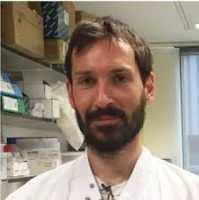Author Interviews, Breast Cancer, Nature / 10.11.2018
Estrogen Receptors More Versatile and Widespread Than Previously Recognized
MedicalResearch.com Interview with:
 Prof. Cathrin Brisken MD, PhD
ISREC, School of Life Sciences
Ecole Polytechnique Fédérale (EPFL)
CH-1015 Lausanne, Switzerland
MedicalResearch.com: What is the background for this study?
Response: Estrogen receptor signaling has been well characterized in various in vitro models, like breast cancer cell lines. Understanding estrogen receptor action in complex in vivo context is much more challenging.
We obtained elegant mouse models in which either all estrogen receptor function or specifically either the hormone dependent (AF-2) or the hormone independent (AF-1) function were ablated. Using the mammary glands from these mice we performed tissue recombination studies to discern the role of the different aspects of estrogen receptor signaling in the mouse mammary epithelium and its different cell populations.
(more…)
Prof. Cathrin Brisken MD, PhD
ISREC, School of Life Sciences
Ecole Polytechnique Fédérale (EPFL)
CH-1015 Lausanne, Switzerland
MedicalResearch.com: What is the background for this study?
Response: Estrogen receptor signaling has been well characterized in various in vitro models, like breast cancer cell lines. Understanding estrogen receptor action in complex in vivo context is much more challenging.
We obtained elegant mouse models in which either all estrogen receptor function or specifically either the hormone dependent (AF-2) or the hormone independent (AF-1) function were ablated. Using the mammary glands from these mice we performed tissue recombination studies to discern the role of the different aspects of estrogen receptor signaling in the mouse mammary epithelium and its different cell populations.
(more…)
 Prof. Cathrin Brisken MD, PhD
ISREC, School of Life Sciences
Ecole Polytechnique Fédérale (EPFL)
CH-1015 Lausanne, Switzerland
MedicalResearch.com: What is the background for this study?
Response: Estrogen receptor signaling has been well characterized in various in vitro models, like breast cancer cell lines. Understanding estrogen receptor action in complex in vivo context is much more challenging.
We obtained elegant mouse models in which either all estrogen receptor function or specifically either the hormone dependent (AF-2) or the hormone independent (AF-1) function were ablated. Using the mammary glands from these mice we performed tissue recombination studies to discern the role of the different aspects of estrogen receptor signaling in the mouse mammary epithelium and its different cell populations.
(more…)
Prof. Cathrin Brisken MD, PhD
ISREC, School of Life Sciences
Ecole Polytechnique Fédérale (EPFL)
CH-1015 Lausanne, Switzerland
MedicalResearch.com: What is the background for this study?
Response: Estrogen receptor signaling has been well characterized in various in vitro models, like breast cancer cell lines. Understanding estrogen receptor action in complex in vivo context is much more challenging.
We obtained elegant mouse models in which either all estrogen receptor function or specifically either the hormone dependent (AF-2) or the hormone independent (AF-1) function were ablated. Using the mammary glands from these mice we performed tissue recombination studies to discern the role of the different aspects of estrogen receptor signaling in the mouse mammary epithelium and its different cell populations.
(more…)


![MedicalResearch.com Interview with: Dr. Theodore Satterthwaite MD Assistant professor in the department of Psychiatry, and Cedric Xia, a MD-PhD candidate Perelman School of Medicine at the University of Pennsylvania MedicalResearch.com: What is the background for this study? What are the main findings? Response: Unlike other branches of modern medicine, psychiatry still solely replies on patient reports and physician observations for clinical decision-making. Without biologically-based tests, the diagnostic categories for mental health do not carve nature at its joint. This is evident in the high levels of co-morbidity across disorders and heterogeneity within disorders. Through this research, we studied a large sample of adolescents who completed MRI-based functional imaging, and used recently-developed machine learning techniques to uncover specific abnormalities that are highly predictive of a wide variety of psychiatric symptoms. Essentially, we tried to find brain patterns that were predictive of different types of psychiatric symptoms. We discovered four such brain-guided dimensions of psychopathology: mood, psychosis, fear, and disruptive behavior. While each of these dimensions exhibits a unique pattern of brain connectivity, a common feature of brain anomaly is shared across the dimensions. Notably, in all linked dimensions, the default mode network and fronto-parietal network, two brain regions that usually become increasingly distinct as the brain matures, were abnormally connected. This loss of normal brain network segregation supports the hypothesis that many psychiatric illnesses may be disorders of brain development. MedicalResearch.com: What should readers take away from your report? Response: This study shows that we can start to use the brain to guide our understanding of psychiatric disorders in a way that’s fundamentally different than grouping symptoms into clinical diagnostic categories. By moving away from clinical labels developed decades ago, we can begin to let the biology speak for itself. Our ultimate hope is that understanding the biology of mental illnesses will allow us to develop better treatments for our patients. MedicalResearch.com: What recommendations do you have for future research as a result of this work? Response: This study demonstrates the importance of incorporating vast amounts of biological data to study mental illness across clinical diagnostic boundaries. Moving forward, we hope to integrate genomic data in order to describe pathways from genes to brain to symptoms, which could ultimately be the basis for novel treatments for mental illness. MedicalResearch.com: Is there anything else you would like to add? Response: Future breakthroughs in brain science to understand mental illness requires large amount of data. While the current study takes advantage of one of the largest samples of youth, the size (n=999) remains dwarfed by the complexity of the brain. The neuroscience community is actively working towards collecting higher quality data in even larger samples, so we can validate and build upon the findings. Citation: Cedric Huchuan Xia, Zongming Ma, Rastko Ciric, Shi Gu, Richard F. Betzel, Antonia N. Kaczkurkin, Monica E. Calkins, Philip A. Cook, Angel García de la Garza, Simon N. Vandekar, Zaixu Cui, Tyler M. Moore, David R. Roalf, Kosha Ruparel, Daniel H. Wolf, Christos Davatzikos, Ruben C. Gur, Raquel E. Gur, Russell T. Shinohara, Danielle S. Bassett, Theodore D. Satterthwaite. Linked dimensions of psychopathology and connectivity in functional brain networks. Nature Communications, 2018; 9 (1) DOI: 10.1038/s41467-018-05317-y [wysija_form id="3"] [last-modified] The information on MedicalResearch.com is provided for educational purposes only, and is in no way intended to diagnose, cure, or treat any medical or other condition. Always seek the advice of your physician or other qualified health and ask your doctor any questions you may have regarding a medical condition. In addition to all other limitations and disclaimers in this agreement, service provider and its third party providers disclaim any liability or loss in connection with the content provided on this website.](https://medicalresearch.com/wp-content/uploads/Cross-clinical-diagnostic-categories.jpg)
![MedicalResearch.com Interview with: Dr. Theodore Satterthwaite MD Assistant professor in the department of Psychiatry, and Cedric Xia, a MD-PhD candidate Perelman School of Medicine at the University of Pennsylvania MedicalResearch.com: What is the background for this study? What are the main findings? Response: Unlike other branches of modern medicine, psychiatry still solely replies on patient reports and physician observations for clinical decision-making. Without biologically-based tests, the diagnostic categories for mental health do not carve nature at its joint. This is evident in the high levels of co-morbidity across disorders and heterogeneity within disorders. Through this research, we studied a large sample of adolescents who completed MRI-based functional imaging, and used recently-developed machine learning techniques to uncover specific abnormalities that are highly predictive of a wide variety of psychiatric symptoms. Essentially, we tried to find brain patterns that were predictive of different types of psychiatric symptoms. We discovered four such brain-guided dimensions of psychopathology: mood, psychosis, fear, and disruptive behavior. While each of these dimensions exhibits a unique pattern of brain connectivity, a common feature of brain anomaly is shared across the dimensions. Notably, in all linked dimensions, the default mode network and fronto-parietal network, two brain regions that usually become increasingly distinct as the brain matures, were abnormally connected. This loss of normal brain network segregation supports the hypothesis that many psychiatric illnesses may be disorders of brain development. MedicalResearch.com: What should readers take away from your report? Response: This study shows that we can start to use the brain to guide our understanding of psychiatric disorders in a way that’s fundamentally different than grouping symptoms into clinical diagnostic categories. By moving away from clinical labels developed decades ago, we can begin to let the biology speak for itself. Our ultimate hope is that understanding the biology of mental illnesses will allow us to develop better treatments for our patients. MedicalResearch.com: What recommendations do you have for future research as a result of this work? Response: This study demonstrates the importance of incorporating vast amounts of biological data to study mental illness across clinical diagnostic boundaries. Moving forward, we hope to integrate genomic data in order to describe pathways from genes to brain to symptoms, which could ultimately be the basis for novel treatments for mental illness. MedicalResearch.com: Is there anything else you would like to add? Response: Future breakthroughs in brain science to understand mental illness requires large amount of data. While the current study takes advantage of one of the largest samples of youth, the size (n=999) remains dwarfed by the complexity of the brain. The neuroscience community is actively working towards collecting higher quality data in even larger samples, so we can validate and build upon the findings. Citation: Cedric Huchuan Xia, Zongming Ma, Rastko Ciric, Shi Gu, Richard F. Betzel, Antonia N. Kaczkurkin, Monica E. Calkins, Philip A. Cook, Angel García de la Garza, Simon N. Vandekar, Zaixu Cui, Tyler M. Moore, David R. Roalf, Kosha Ruparel, Daniel H. Wolf, Christos Davatzikos, Ruben C. Gur, Raquel E. Gur, Russell T. Shinohara, Danielle S. Bassett, Theodore D. Satterthwaite. Linked dimensions of psychopathology and connectivity in functional brain networks. Nature Communications, 2018; 9 (1) DOI: 10.1038/s41467-018-05317-y [wysija_form id="3"] [last-modified] The information on MedicalResearch.com is provided for educational purposes only, and is in no way intended to diagnose, cure, or treat any medical or other condition. Always seek the advice of your physician or other qualified health and ask your doctor any questions you may have regarding a medical condition. In addition to all other limitations and disclaimers in this agreement, service provider and its third party providers disclaim any liability or loss in connection with the content provided on this website.](https://medicalresearch.com/wp-content/uploads/Cross-clinical-diagnostic-categories-200x180.jpg)


